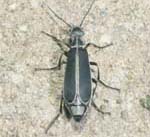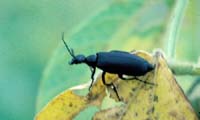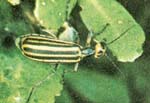Blister Beetles
Striped Blister Beetle or Old-Fashioned Potato Beetle Epicauta vittata
Ash-Gray Blister Beetle Epicauta fabricii
Black Blister Beetle Epicauta pennsylvania
Margined Blister Beetle Epicauta pestifera

Figure 1. Margined Blister Beetle Adult
Description
Blister beetles are one-half to one inch. long
and have comparatively soft bodies. The head is broad and vertical. The
section of the body between the head and the wings (prothorax) is
distinctly narrower than the wings, and usually is slightly narrower
than the head. Thus it appears that the insect has a neck. The wing
covers are soft and flexible, and the legs are comparatively long.
Striped blister beetles are about 5/8 inch long and one-fourth as wide.
They are gray to brown with yellow stripes running lengthwise of the
wing covers. The ash-gray blister beetle is about 1/2 inch long and is
completely gray. The black blister is about 1/2 inch long and is solid
black. The margined blister varies from 5/8 to 1/2 inch long and is
black with a gray to cream band around the edge of each wing cover.

Figure 2. Black Blister Beetle Adult
Life History
Blister beetles lay their eggs in masses in
soil where grasshoppers normally deposit eggs. The newly hatched larva
searches for a grasshopper egg pod. Upon finding one, it chews its way
into the rod and begins to feed. With each molt, its legs become less
distinguishable. At the last molt, the larva again becomes active,
crawls out of the grasshopper egg pod, and pupates in the soil. In 10 to
20 days it emerges as an adult. These insects winter primarily as
almost mature larvae. There is probable only one generation a year.
Damage
The larvae of the common blister beetles are
beneficial, since they destroy grasshopper egg pods. Heavy infestations
often occur during or just following a grasshopper outbreak. The black
blister beetle adults are largely pollen feeders, but they also feed on
alfalfa blossoms. The margined and ash-gray blister beetle adults feed
primarily on the flowers and blossoms of plants, but they may also feed
on the leaves. Striped blister beetles often appear in great swarms and
seem to concntrate on particular rows. In solid plantings, they strip
plants over a circular area. This species usually damages vegetables
more than forage crops. Heavy populations of blister beetles in
green-chopped forages have rendered the feed unplantable to cattle.
Blister beetles have an oily substance, cantharidin, in their body
fluide that causes large blisters t oform when a beetle is crushed on a
person's skin. Unless properly cared for, these blisters can become
infected.

Figure 3. Striped Blister Beetle Adult
Control
Blister beetles rarely cause economic damage to
alfalfa, but they can cause problems as a contaminant in baled hay.
Blister beetles contain an oily, caustic substance in their body fluids
called cantharidin that helps protect them from natural enemies.
Cantharidin is toxic and can severely injure livestock, particularly
horses, when beetles are ingested with the hay. In fact, the beetle
itself does not have to be ingested; hay contaminated with the body
fluid of crushed beetles can be equally dangerous. The chemical
irritates the stomach lining, small intestine, bladder, and urinary
tract and reduces the calcium level in the blood. Horses that have
ingested cantharidin may exhibit signs of colic, including excessive
salivation, sweating, cramps, and urinary straining; a fatal dose will
include fever, depression, shock, and death.
Cantharidin concentration in beetles varies by species. Some species may have 50 times more cantharidin than others. In addition, horses differ in their sensitivity to cantharidin. These variables, plus certain aspects of blister beetle behavior, make it difficult to establish strict guidelines for determining thresholds in hay. Some research suggests that as few as 5 to 10 beetles, when ingested, could cause severe injury and death in horses, but other research indicates that 30 or more beetles would be required.
Some blister beetle species tend to aggregate in clusters in a field, while others do not. Aggregating beetles may cause more problems because a few bales could contain many beetles, making contaminated bales much more toxic. Because of these variables, many horse owners require that the hay they purchase be blister beetle free. Cases of cantharidin poisoning in horses are rare in Illinois, but that is no solace to a horse owner who suffers a loss. The following steps will help to avoid a poisoning.
- Use first-cutting hay to feed horses. Nearly all blister beetle species will still be immature during the first harvest of hay. Most adult beetles will die by late September, so the last cutting also should contain fewer beetles.
- Harvest later cuttings of hay while the alfalfa is still in the vegetative stage. Research conducted in Kansas indicated that significantly higher blister beetle densities were found in bud- or bloom-stage alfalfa.
- Scout alfalfa for blister beetle infestations before taking the
second, third, and fourth cuttings. Sweep several sites (10 to 20 or
more), especially in alfalfa near field borders, ditches, and weed
spots. If blister beetles are present:
- Cut hay without crimping or conditioning so that blister beetles are not killed, and leave wind-rowed hay as it is drying. This may not be very practical for most operators, but it has been shown to reduce the presence of dead blister beetles in hay.
- Do not feed this hay to horses.
- Consider the application of an insecticide. Carefully read the label for preharvest restriction guidelines and other instructions.
- It is sometimes suggested that the purchaser inspect hay before feeding. This may be unrealistic for most horse owners because it requires large amounts of time to thoroughly inspect the hay for dead beetles.
- Horse owners who buy alfalfa hay should purchase only first-cutting hay. If later cuttings must be purchased, request that the hay suppliers follow the steps outlined previously.
If you suspect that your horse has been poisoned by blister beetles, contact your veterinarian immediately. Treatment will often include administration of activated charcoal and a saline cathartic, fluids, and mineral oil. A veterinarian also will monitor the horse's heart rate and control diaphragmatic flutter that is often associated with low blood levels of calcium.--Mike Gray